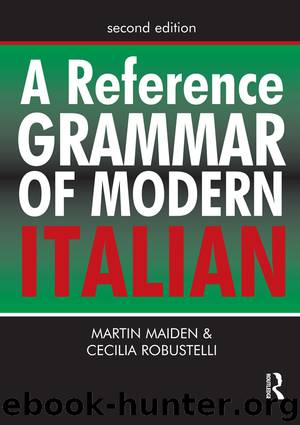A Reference Grammar of Modern Italian by Maiden Martin; Robustelli Cecilia;

Author:Maiden, Martin; Robustelli, Cecilia;
Language: eng
Format: epub
ISBN: 564551
Publisher: Taylor and Francis
14.6
The desinences of the present tense
The present tense is characterized by the following desinences attached to the root of the verb.5
TABLE 14.B
The conjugation of the present tense of andare, fare, avere, dare, sapere, stare is given in 14.3. Note particularly the monosyllabic forms in the first person singular (except andare and fare), pronounced [ɔ], [dɔ], [sɔ], [stɔ], and that their third person plural forms are formed by adding -nno to the third person singular.
It will be seen from 14.2 that there are two kinds of present tense form of third conjugation verbs (dire and compire are special cases, see 14.3 and 14.5): one, like dormire, forming its present in the manner indicated above, and another, like finire, for which the element -isc- appears between the root and the desinence in all singular forms, and in the third person plural (but not in the first and second persons plural). The majority of third conjugation verbs follow finire, but there is a relatively small group (many of which are, however, in very frequent use), whose present desinences - but not necessarily their roots - follow the pattern of dormire. These verbs need to be learned as a list. They are:
aprire ‘open’; coprire ‘cover’; cucire ‘sew’;fuggire ‘flee’; morire ‘die’; offrire ‘offer’;partire ‘leave’; pentirsi ‘repent’; sentire ‘feel’; salire ‘go up’; soffrire ‘suffer’; uscire ‘go out’; udire ‘hear’; venire ‘come’
Download
This site does not store any files on its server. We only index and link to content provided by other sites. Please contact the content providers to delete copyright contents if any and email us, we'll remove relevant links or contents immediately.
Housekeeping by Marilynne Robinson(4059)
Papillon (English) by Henri Charrière(3902)
The Poetry of Pablo Neruda by Pablo Neruda(3813)
World without end by Ken Follett(3340)
TCP IP by Todd Lammle(3011)
Fluent Forever: How to Learn Any Language Fast and Never Forget It by Gabriel Wyner(2915)
The Rape Of Nanking by Iris Chang(2646)
How Proust Can Change Your Life by Alain De Botton(2609)
The Alchemist by Paulo Coelho(2583)
The Partner by John Grisham(2280)
Two lives by Helen Naylor(2187)
Hitler by Ian Kershaw(2043)
Yerma by Federico García Lorca(1920)
Sophie's World by Jostein Gaarder(1904)
Smilla's Sense of Snow by Peter Hoeg(1853)
Merriam-Webster's Pocket Dictionary by Merriam-Webster(1819)
Il cavaliere inesistente by Italo Calvino(1785)
Twilight of Idols and Anti-Christ by Friedrich Nietzsche(1758)
Deep Writing by Eric Maisel(1737)
